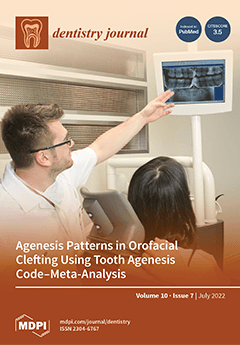The aim of this study was to evaluate the color stability of esthetic ceramic brackets and adhesive samples after immersion in most commonly consumed beverages. A hundred ceramic brackets from five different manufacturers (Forestadent
®, G&H
®, GC, DynaFlex
®, and American Orthodontics) and 120 samples of adhesives (3M™Transbond™ XT and American Orthodontics BracePaste
® color change adhesive and BracePaste
® adhesive) were immersed into four different solutions: coffee, Coca-Cola
®, the vitamin drink Cedevita
®, and artificial saliva (control group). The samples were kept in an incubator at 37 °C. Color readings were evaluated before (T0), at 24 h (T1), 72 h (T3), 7 days (T4), and 14 days (T5) after initial immersion using a spectrophotometer according to the L*a*b* color scale. All the examined brackets showed a statistically significant difference in discoloration (
p = 0.001). 20/40™ Brackets (American Orthodontics) showed the best color stability, while the greatest color modification was recognized in QuicKlear
® III (Forestadent
®) brackets. Regarding adhesives, the greatest staining was observed in the BracePaste
® color change adhesive and the least in the Transbond™ XT samples. In conclusion, color change occurs in all solutions, including control groups, and coffee has the greatest impact on color stability.
Full article






